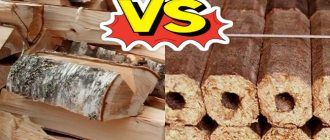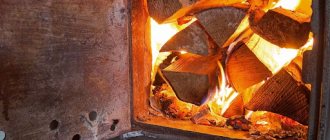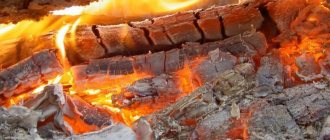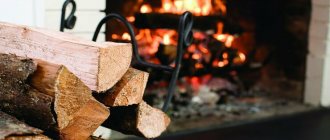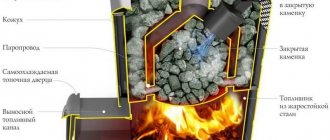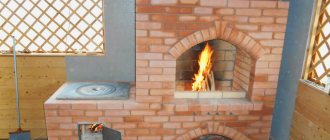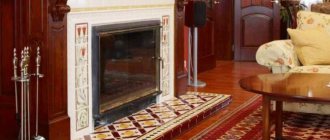Types of coal. Pros and cons of use
Certain types of solid fuels are transformations of the same organic material. For example, peat is formed primarily from dead plant matter in swamps. It is then coalified and converted into brown coal. At the next step - into coal.
The disadvantages of peat and brown coal are a large amount of upper moisture. If you dry them perfectly, they will crumble. This can be eliminated by pressing peat into briquettes. However, when burned, this fuel produces a lot of ash. This makes maintaining the stove difficult: you regularly need to clean the grates and ash pan, but even this is made difficult by the fact that the ash is lightweight and is sprayed around the room.
Peat in briquettes is compressed with sawdust, which makes it higher quality, convenient for storage and use. Brown coal is not beneficial for the combustion chamber of a furnace, which is why it is almost never used. In addition, it has a low calorific value (3000±500 kcal/kg) and, based on this, efficiency.
The main principle of choosing fuel for a home with a solid fuel boiler
If you make a request on the Internet, the better and cheaper way to heat a country house with a solid fuel boiler, then dozens of offers and reviews will appear where people talk about their experience. Some just for firewood. Others praise fuel briquettes. And still others prefer coal. The situation is aggravated by the fact that often, suburban residents consider their point of view to be the only correct one and do not want to listen to others. Many copies have been broken in such disputes. How to proceed and come to a common denominator? The solution is to narrow the search for a certain ideal type of fuel for a solid fuel boiler, adhering to the following recommendation.
The more economically profitable the fuel is, the more of it is available on the market (or there is free access to it at a reasonable price) in a particular region of residence of the homeowner.
Somewhere this is firewood. In other places, the processing of wood waste into fuel briquettes is well established. And in coal-mining regions, this type of fuel, especially if it is possible to choose a deposit with high-quality coal, is beyond competition.
There may be another option, when there is a choice of two or three main types of fuel for TT boilers, but a person cannot decide and choose the most rational one. Next, we will talk about real experience of use, as well as the pros and cons of firewood, fuel briquettes and coal.
Combustion chamber of a coal furnace
Hard coal has better parameters than brown coal. Its calorific value is 6000±500 kcal/kg. Various varieties are distinguished by the degree of ash content and the amount of volatile substances:
- Coal (low ash, low in volatile substances).
- Gas (low ash, rich in volatile substances).
- Shale (forms a lot of ash, has a lot of moisture).
For use in home stoves, the most convenient type of coal is hard coal. It stores well and does not spontaneously combust. It is enough to simply pour it in the barn on the floor or in drawers. But firewood is used to ignite it, since it takes a long time to light up on its own. It is necessary to say something about the design of the combustion chamber. It must be designed to use this type of fuel. Its device is distinguished by an additional channel for supplying secondary air. Also, its role can be played by a blower or a half-open flap of the combustion chamber.
Coal is excellent, wood is better
Wood is considered the optimal solid fuel for stoves. It has good parameters for energy-saving heat supply:
- ash content up to 1%,
- yield of flammable substances up to 85%,
- absence of sulfur in the composition, which destroys the furnace inside,
- calorific value 4500 kcal/kg.
Hard woods are difficult to split, but they generate high heat. Plus, they burn for a long time, organizing burning coals with good heat transfer. The working time of the combustion chamber on one fill is longer than that of firebrands made from soft varieties of trees. Solids include:
- hornbeam, oak, yew, beech, ash, hazel.
Excellent of the best: fruity, birch and linden
This list is also supplemented by fruit trees: pear, apple tree. They emit a good smell and burn well, but it is difficult to kindle with any hard logs. Birch and linden are considered excellent for the combustion chamber of a furnace. Birch produces a small amount of moisture even in its raw form. Logs can be placed in the combustion chamber without drying; they will still give off great heat and will smolder for a long time.
Linden is valued for its healing qualities. If you heat the stove with linden wood, there will be a healing climate in the house or bathhouse. Linden burns slowly, with good heat transfer. Likewise, hardwoods are excellent varieties, and among these are birch and linden.
Softwood
Soft varieties of wood melt quickly, but require drying to a residual moisture of 20% and good preservation. These include coniferous varieties. Cons: a decent amount of resins, high sparkle (with an open combustion chamber, the fire hazard increases). Mainly popular types are used: pine and spruce. They are easy to chop and saw, the cost of purchasing this firewood is not high.
Conifers
These rocks are good for heating stoves. They burn well, but only for a short time. Scattering sparks in all directions creates an unsafe situation.
Pine
Pine firewood contains resin, which contributes to the formation of soot in the firebox and chimney. Working with pine leads to the appearance of tart fumes in the air due to the combustion of resin.
Spruce
Spruce firewood burns just like pine wood. Working with spruce logs leads to the release of essential oils. This is accompanied by toning of the respiratory tract.
What is the best way to heat the stove?
Nowadays, manual labor has been replaced by various types of equipment that simplify the work, regardless of its volume. And yet, what is better for the combustion chamber of furnaces?
Humanity knows a lot of different types of firewood. Classically, anything that can burn and is very easily prepared is used, such as peat coals or dried cattle manure. Let's skip exotic types of firewood and indicate only the important ones.
Among deciduous trees , birch, alder, aspen and oak are considered very popular. You can also add linden, poplar, maple, ash, elm, cherry, apple, pear, willow and walnut firewood.
Among coniferous species, spruce and pine are popular. But you can also find fir, cedar and larch firewood. Juniper and yew trees are more likely to be considered exotic conifers.
The wood described has different densities, therefore different weights, and also resin content. The combustion time and the energy released depend on the first parameter. The higher the density of the tree, the longer it will smolder. The same rule applies to the part of the trunk from which the logs are prepared. Closer to the surface of the earth, wood is denser and harder to split. Woodworkers know this property, so they consider this part of the trunk to be the best.
Similar trees are suitable for the production of kindling chips because they do not require prolonged ignition. At the same time, the resin smokes stronger during the combustion process, which turns out to be the basis for rapid clogging of the chimney.
In reality, this conclusion is not very obvious. With a good choice of stove design and the best combustion mode, you can avoid the formation of a very large amount of soot. Residents of taiga zones use this type of firewood and have never complained about this problem.
Depending on its density, wood can be divided into three key groups:
- Soft : pine, cedar, spruce, fir, aspen, alder and linden.
- Medium hard : birch, cherry, plum, elm, juniper.
- Hard : oak, hornbeam, maple, apple, pear, ash.
Below is a table of the relative densities of different tree species. The unit used is the density of one cubic meter of oak.
Based on the table, we conclude that spruce, when compared with oak, is 1.5 times larger. In other words, a ton of spruce wood will take up 1.5 times the volume of oak wood.
Rare types of firewood
Oak
is the best firewood for the stove. The wood is dense, burns for a long time, gives high heat transfer, and is very economical, because compared to other firewood, much less is consumed to heat the same area. Due to its high cost, it is often used as an additive to other wood. A pair of oak logs will make the burning more intense and longer.
Good oak firewood comes from middle-aged trees; when burned, they release a pleasant tart aroma. Oak firewood is ideal not only for stoves, but also for fireplaces.
Excellent, but also one of the most expensive - alder
firewood. They burn hot, without smoke or soot, spreading a pleasant aroma.
Alder cannot be confused with any other firewood; when cut, it has a color from yellow to deep red. Perhaps this is the best firewood for a fireplace; it burns with a mesmerizing, even flame of a beautiful color. A big plus is that alder firewood lasts a long time and can be stored for future use for 5-6 years.
Rare firewood includes linden
. Although linden is common, linden firewood is rare. The wood is hot, although it takes a long time to burn, but then the stove heats up very quickly. The aroma that comes from linden when burned has healing properties. A bathhouse heated with linden firewood is useful for colds, diseases of the bronchi and lungs, and has a beneficial effect on the condition of the skin.
Regardless of what type of firewood you purchase, make sure that the wood is not rotten. The benefits of rotten mushrooms are zero. In order for the wood to burn, giving off maximum heat, it must be dry. Undried wood burns poorly, produces a lot of smoke and little heat.
For thousands of years, our ancestors used wood (firewood) as fuel. And today, despite the widespread use of natural gas or coal, they remain a popular type of fuel.
At the dacha or in the countryside you can’t do without them. Wood from different trees can be used as fuel. They all have their own characteristics.
What kind of firewood is perfect for lighting stoves?
It should be noted that different tree species have almost the same ability to generate heat per unit weight. In this case, dense wood itself will generate more heat by one unit of volume. Thus, a birch log emits 20-30% more heat than a pine log.
The calorific value of wood has an inverse harmonious relationship with moisture: the wetter the wood, the less heat it emits. In most cases, 20-25% is considered suitable humidity. The rate of freshly cut firewood is 50%. Therefore, dry logs provide 3 times more heat than raw logs.
Such a dependence makes it possible to draw the only correct conclusion: the timber must be kept dry. The best option is to dry it outside for a year. In this case, the firewood must be protected from precipitation or stored in a ventilated woodshed. Such logs will be very effective in a combustion chamber.
A couple of phrases about calorific value
In terms of its chemical composition, wood is a rather complex material. It contains the main components - lignin and cellulose. But besides them, the tree contains:
- resins;
- proteins;
- tannins and other ingredients.
When logs burn in a stove (or simply when trees burn in a forest), these components interact with the air at a chemical level. The calorific value of wood (as well as any fuel), or thermal conductivity, is the amount of thermal energy that a unit of weight of the fuel material (in our case, 1 kg of wood) produces during combustion. Kilocalories are used to measure quantities.
The chemical composition among most tree varieties has minimal variations, which causes differences in the number of calories emitted. That is, the heat of combustion of some types of firewood can be as follows:
- for deciduous species the figure is 4460 kcal/kg;
- for coniferous species - 4560 kcal/kg;
- for mixed breeds – 4510 kcal/kg.
As you can see, the differences are minimal. At the same time, it is easy to understand that it is better to use coniferous wood for the stove due to its greater thermal conductivity. Only firewood is supplied to the market depending on volume, not weight. That is, the main criterion for choosing firewood is cubic meters. Density plays an important role here, because the higher it is, the heavier the wood.
For example, let’s take 1 cubic meter of birch logs as a starting point. Then the ratio of the volume of different rocks will look like this:
- oak logs - 0.75 cubic meters. m;
- alder logs - 1.1 cubic meters. m;
- pine logs - 1.2 cubic meters. m;
- spruce logs - 1.3 cubic meters. m;
- aspen logs - 1.5 cubic meters. m.
That is, 1 cubic meter of birch and 0.75 cubic meters. m of oak logs, 1.1 cubic meters. m of alder wood (and so on) will produce the same amount of heat. Knowing this, now, depending on how much firewood costs, you can get profitable savings for yourself.
Firewood or coal: which option is better?
Coal is perfect for boilers of heating systems that are installed in an individual room or building. It is not recommended to burn this substance in a stove mounted in a living room, because coal burns for a long time and rarely burns completely. For this reason, do not leave the chimney closed to prevent carbon monoxide from entering the room. In this case, the firewood will quickly decay, releasing a large amount of heat. The logs burn completely, which means you can close the valve without a twinge of conscience, without fear for your own health and heat leakage through the chimney.
Lighting coal without wood and the necessary means is considered a very difficult task. Because of this reason, everyone who uses similar fuel is forced to buy firewood in order to light the stove with it. Dust from coal is harmful to health, so when throwing fuel into the stove, you must try to prevent these particles from rising into the air and dirtying everything around. Logs, on the contrary, have almost no dirt and foreign impurities, and therefore are safer.
Preparing for the firebox
In order for the process of heating the premises to be as effective as possible, you need to prepare for this process in advance.
Firewood harvesting
When harvesting, use trees that grow in dry places; they have less humidity, which means they will burn with greater heat transfer. If this is not possible, then the cut trees must be thoroughly dried.
The best time to collect firewood is November-December. Do not leave cut trees for a long time; if possible, “split” them into parts. Logs suitable for heating the stove should not be too large or very small. The most common sizes for firewood are 8–10 cm in diameter, the length depends on the size of your stove.
Harvesting firewood is a labor-intensive process
Storage
After cutting down, it is best to split the trees and only then put them in a special room that is well ventilated, there is no excess moisture, and rain or snow does not fall into it. Basement areas are not suitable for this; it is better to use sheds with good ventilation.
It is advisable to keep the firewood “in reserve” for about 2–3 years before using it, during which time most of the moisture in the firewood will evaporate, leaving no more than 15%. Dry wood is easier to ignite, it burns with high heat output, and does not damage the components of the stove heating system due to the absence of condensation settling in the chimney and pipes.
Over time, the chimney becomes clogged and draft deteriorates. Thorough cleaning will solve the problem. You will learn about the means and methods in our material: .
A great way to stack logs is in criss-cross racks.
One of the options for stacking firewood
Furnace inspection
The serviceability of the stove - the absence of chips, cracks, burnouts - is the key to a long and flawless service of this heating device. Try to inspect the oven regularly and, if any faults are found, correct them in a timely manner.
Before you start kindling, do not forget to take care of good draft, check the operation of the damper, clean the chimney, and make sure that the room is well ventilated.
Compliance with fire safety regulations
A stove is a device that requires careful adherence to certain rules:
- Timely repairs and cleaning of all furnace components.
- Whitewashing the outer part (for quick detection of cracks, etc.)
- Do not leave ovens unattended. Especially if there are small children in the room.
- Nail a metal sheet in front of the firebox (for safety in case of sparks hitting the floor).
- You should not heat the stove for more than 1.5 hours at a time, no more than two or three times a day (so as not to overheat it).
- You should not light the stove just before going to bed (optimally three hours before going to bed).
- Do not place wooden furniture or utensils near the stove.
- Use firewood that matches the size of the firebox opening.
- Close the chimney valves only after the firewood has completely burned.
- Do not use flammable materials (gasoline, kerosene, etc.) for lighting.
Cautions
Many people who use a furnace are aware of the dangers that carbon monoxide can cause. It is not always possible to determine that this has happened. Therefore, try to never go to bed without checking the coals in the stove, and do not leave them unattended at night.
The occurrence of carbon monoxide may be indicated by the fading of fuel in the firebox; sometimes this happens when using damp firewood. If you suspect the formation of carbon monoxide “killer”, close the fuel door and open the valve and view completely. 10–15 minutes will be enough to protect yourself and your loved ones from carbon monoxide poisoning.
Is it necessary to heat with peat?
Peat is briquetted because it has a sufficient amount of moisture before drying, and after this procedure it crumbles. Thanks to compaction, a similar difficulty is eliminated, but this will not be the reason for reducing the formation of ash in large quantities during the combustion process. This disadvantage is considered significant when using peat. Cleaning and maintaining the stove are considered labor-intensive processes. With a combustion chamber containing this flammable substance, a similar task becomes several times more difficult, because a constant operation of removing ash from the grate and ash pan is required, during which these harmful particles try to scatter throughout the living space.
How to store it correctly?
To maintain the quality of firewood for a long time, you need to ensure proper storage. No special conditions are required for this; a number of points need to be taken into account:
- The woodpile should not be located in a low place where water can accumulate. Otherwise, the wood may rot.
- Logs should be stacked loosely to ensure good ventilation.
- To provide protection from precipitation, a canopy is made.
- There is no need to stack firewood immediately after harvesting. It's better to do this in a few months.
- It is recommended to store it near the house so that there are no difficulties with access to the woodpile.
What can you use to heat a stove besides firewood? We are considering peat and coal.
A heat source in a house where it is not possible to install equipment that runs on gas is considered to be a stove. Its action is based on the selection of natural heat that is released when a specific fuel is burned. There are several types of stoves, which may differ in their external characteristics and internal technical structure. External parameters arise based on the requirements for the size of the room. Technical designs are aimed at very effectively using the noted heat for their own purposes.
It is no secret that the effectiveness of the heating system is influenced by several factors: the design of the furnace, efficiency, type of fuel. The doctrine demonstrates that the heat released during the combustion of a specific mass of different types of fuel is different. Its greatest value falls on the share of firewood. But the choice of fuel will depend not only on this; availability or manufacturing costs make a significant contribution to the decision on how to produce heat. In this article we will try to find out what else you can use to heat the stove, besides ordinary firewood.
Often you have to decide what to heat the stove with besides firewood. We have to refuse this good type of fuel for some quite objective reasons. As a replacement, you can consider briquette peat and coal. Despite the fact that their nature of origin is the same, their properties and calorific value stand out.
In order for fuel to be used specifically, it often has to be processed, dried, chopped, and chopped in advance. Peat has a lot of water inside, which makes it dryable. However, when dried, it crumbles and becomes not so much unsuitable as inconvenient to use. Thanks to this, it is subjected to pressing with the addition of sawdust into specialized briquettes.
The key indicator for any type of fuel is its specific heat of combustion. It demonstrates how much useful energy can be obtained if a fixed amount of fuel is completely burned.
For peat in a variety of variations, this value will not exceed 17 MJ. But we cannot evaluate some physical quantities by their full value, so for comparison we will present a fragment of the table of values.
Amount of heat in MJ released by the following types of fuel:
- coal - 27.00;
- brown coal - 12.98;
- coal-coal - 28.05;
- peat - 12.10;
- peat in briquettes - 17.58;
- peat in the form of crumbs - 10, 84.
Coal is a natural, not man-made, origin. In certain regions of Russia, coal is mined, which is enough not only to supply the domestic market, but also for the purpose of selling it at a stage.
But coal is divided into more than ten types, which are distinguished by the age of its development. It is easy to guess that much higher quality rocks are distinguished by the duration of their occurrence in the layers. There are three types of coal specifications, although the same grades are involved in each of them.
- Classification according to the time of formation development. This division emphasizes 4 types of coal: lignite, brown and hard coal, coal-coal. These breeds are listed in order of increasing age. They are also distinguished by their physical characteristics. Lignite is presented in the form of crumbs, since it cannot hold its shape. Brown coal is also not particularly reliable, but it can already be used in home stoves. Although its calorific value is far from its substitutes. Coal is considered a very common and affordable type, and coal is considered the best quality rock.
- Classification by moisture and content of volatile compounds. In this gradation, known rocks appear in a similar order. Their humidity decreases from 40% to 5%. A similar picture appears with volatile substances. In this division, coal occupies a profitable position.
- Classification by calorific value. We were forced to introduce the calorific value parameters earlier, so duplicating the indicators is pointless. It should only be emphasized that such a classification is considered decisive when choosing fuel for a home stove.
Instructions for firing the stove
Algorithm of actions:
- Place crumpled pieces of paper and thin wood chips in the grate area. You can put 1-2 small logs.
- Open the ash pan door by ¼ and the chimney valve by ½.
- Set the paper on fire using matches. After the fire has started, you should increase the amount of air supplied by opening the vent by ½.
- After the entire paper-wood structure has ignited, gradually add more wood as it burns out.
- Re-laying of firewood must be done when large coals have formed (about half an hour after the first laying).
- The combustion process is controlled by a valve and a blower.
A very important indicator that you need to pay attention to is the color of the flame. The color of the straw indicates a normal combustion process. If the flame has changed color and turned white, and you hear a strong hum in the outlet channels, then this is a sign of increased draft, you need to cover the ash pit. Red flames and black smoke from the chimney are indicators of insufficient draft; the vent needs to be opened slightly.
Video: how to light a brick oven with your own hands
How to drown in black
Special mention should be made of the nuances of firing a stove in black, although such devices are no longer as common as in past centuries. In modern times, baths are mainly heated in this way: the efficiency in this case is very high, much higher than in “white” baths. Little fuel is required for good heating.
Combustion products in such structures do not exit through the chimney, but through the windows and door. A lot of soot settles on the walls, but you should not be disdainful, since in this situation it acts as an adsorbent.
Procedure for black stoves (in the bath):
- Open the windows and door to bring in fresh air and maintain the combustion process.
- Stack the firewood in a “house”, placing scraps of paper under it and set it on fire.
- Before laying firewood for the second time, it is necessary to spill water on the walls and shelves.
- Gradually add firewood, finishing the fire when crimson light appears above the stones.
- It is necessary to wait until the last portion of firewood burns out and remove the coals remaining after that.
- Ventilate the room by opening the windows and door.
- Rinse doors and shelves with cold water.
- Splash a tub of water on the heater and close the doors.
First fire of the new furnace
If the stove is just folded and everything is ready for kindling, then remember a few useful rules.
Firstly, take your time and let the masonry dry. This may take 2–3 days. Light the stove, following all fire safety rules, and see if there is any smoke. Then touch the stove in different places, it should warm up evenly, without temperature changes. Also, the stove, folded correctly, should cool to the same extent.
Secondly, test the quality of the masonry. The density of the laid brick should not allow smoke to pass through. For this test, burn synthetic materials that smoke heavily in the firebox and see if smoke escapes.
If everything went well, the oven can be used!
You may find this material useful on how to properly build a brick oven yourself:.
Fire up the stove after a long period of inactivity
After winter, when you arrive at your dacha, you will want to warm up and light the stove. This must be done in such a way as not to cause damage to either the stove or the residential or bathhouse building itself.
First of all, you need to inspect the oven from the outside and inside to detect:
- cracks;
- chips;
- foreign objects;
- small animals and birds;
- excess soot.
All this can become an obstacle to the normal operation of the furnace. Chips and cracks must be eliminated by sealing them with mortar, and foreign objects must be removed. To clean the chimney of soot, you can use a special metal ball on a long rope. The ball, which is often equipped with a wire brush, is lowered “down the shaft” and raised up, repeating these manipulations several times, shaking off the soot after each rise.
A mandatory action before heating the stove after a long break is checking the draft. Firewood is set on fire with all doors open (ash pan, ash pit, fire door), then they are closed, adjusting the degree of exhaust.
Sometimes the lack of draft can be due to a large amount of cold air in the chimney. Therefore, heating the chimney part of the stove will help eliminate this problem.
We lay two logs parallel to each other at some distance, then place the other two on top of them, placing them perpendicular to the first row. It looks like a mini-well, inside which you need to place paper, a piece of birch bark and splinters.
A stove that has not been fired for a long time cannot be used at full capacity right away; try to ensure that the heating process is gradual, starting with short time intervals.
Proper fuel stowage
People who are far from the firebox of a stove may be surprised to learn that proper placement of fuel can affect the operation of this device.
The most commonly used methods for stacking firewood are:
- horizontal (rows of firewood follow each other with uniform distances between them);
- conical (they build something like a hut from logs);
- diagonal (the first log is laid diagonally in the firebox, all others - at an angle to it).
This is what one of the options for stacking firewood in the stove looks like
The firebox should not be filled to capacity; approximately a fifth should remain free.
When using coal, kindling is done with wood, then, when the fire flares up, a layer of coal is poured (about six centimeters). The height of subsequent layers can reach up to fifteen centimeters, but the coals must allow air to pass through well. It is advisable to stir the coals periodically using a poker or other special devices.
Warm up in the cold (including in winter)
The cold season, especially winter, requires more frequent use of the stove. When trying to warm the room as much as possible, you should not heat the stove too often or too much, as you can cause it to overheat. An overheated stove can collapse faster, the brickwork begins to crumble, burnouts appear in the channels, etc.
Therefore, heating in the winter season needs to be done wisely: heat the stove moderately, twice a day is enough. If you want to “add up the heat,” then conduct each subsequent fire at intervals of at least four hours.
Specifics of furnaces using coal
The vast majority of the real models of stoves that we remember from our grandparents were adapted for the use of wood and coal. This smoothing of the structure was carried out precisely because it was difficult to predict what would have to be used to heat the stove in each specific season. But, if you approach the construction work of the furnace in detail, then such options should vary.
The temperature inside the combustion chamber when coal is ignited is much higher than when wood is ignited. This results in the walls of the iron combustion chamber being enlarged using much thicker sheets. The combustion volume becomes larger due to the lower placement of the grate. The ash pit should be built to be larger in volume, since the amount of ash during coal operation is much greater than that of firewood.
Pellets
Lighting a stove with pellets is the newest type of heating.
Pellets are cylindrical granules of the same size made from wood waste. In a good way, to effectively heat a room with pellets you need a special boiler. But to meet minimal needs, they can be used in a conventional wood-burning stove.
Advantages of pellet heating:
- — environmentally friendly fuel, contains no more than 3% ash;
- — granules do not contain dust and spores, are less susceptible to spontaneous combustion and do not cause allergies;
- — characterized by high dryness and greater density, which leads to high heat transfer;
- - ease of storage
The main disadvantage of pellets is their high price.
Tricks for lighting a stove
Many people are predisposed to incorrectly evaluate fuel by the ease of its ignition. It will not be possible to light coal without firewood, plus, the ignition process itself must be carried out correctly. This contributes to a long service life of the stove.
The oven needs to be looked at from the outside every time you prepare to dissolve it. Substances or objects that easily ignite and were accidentally placed nearby are removed at a sufficient distance in advance. Before kindling, the chamber and ash pan must be cleaned, removing unburned food. To prevent very small particles of ash from flying around the room, it is recommended to pour a little water into the ash pan.
Household waste containing plastic or bitumen cannot be used for kindling, as they are considered the basis for the formation of a decent amount of soot in the chimney. The combustion chamber flap and the blower do not have to be open in pairs. This rule is useful, just as when kindling you have to adjust the draft.
Coal is stored indoors in most cases, but moisture penetration is very likely. In this case, it must be dried in advance. When burning wet coal, all the water in the form of steam goes into the chimney. A decent amount of soot settles on the wet surfaces of the pipe walls.
Crumpled old newspapers are placed on the grate. Very small wood chips can be placed on top of them. Wood logs are placed in a hut or a well, it all depends on your habits. Then we light the stove by closing the combustion chamber door and opening the ash pan.
When the firewood begins to burn out and the first hot firebrands appear, you can add a portion of very small coal, after which very large pieces are gradually added. When burning coal, you should close the chimney damper, this will save heat. But don't forget that if the damper is closed, there is a possibility of filling the room with carbon monoxide. You need to monitor the flame, the blue tint indicates that it is time to open the damper.
Chimney cleaning before the start of the heating season by specialists
The chimney cleaning service is available in: heating industry specialists will carry out a full range of measures for servicing the chimney:
- Inspect the internal contour of the chimney for the presence/absence of dirt, debris, soot build-up and condensation. Cleaning the internal circuit from any detected contaminants using special devices.
- Inspection of the external contour of the chimney for the presence/absence of damage, cracks, depressurization, inspection of the condition of joints and fastenings, insulation. Eliminate any detected defects and damage promptly.
- Lighting up the heating device, checking the draft level, the quality of the flue gas output, comprehensive testing of the performance and safety of heating and smoke exhaust equipment.
- Drawing up a certificate of work performed and providing warranty obligations.
Attention! If you clean the smoke duct yourself, it is recommended to follow fire and technical safety measures, as well as use specialized devices - a brush, a cable with a load, and others.

